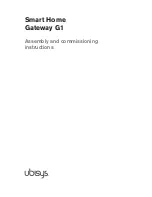
CoA, RADIUS DM, and Session Redirection (Hotlining)
▀ RADIUS Change of Authorization and Disconnect Message
▄ Cisco ASR 5x00 Packet Data Network Gateway Administration Guide
234
3GPP-NSAPI: Network Service Access Point Identifier (NSAPI) should match to the NSAPI specified
for specific PDP context.
User-Name: The value should exactly match the subscriber name of the session. This is one of the preferred
methods of subscriber session identification.
Framed-IP-Address: The values should exactly match the framed IP address of the session.
Calling-station-id: The value should match the Mobile Station ID.
To specify the ACL to apply to the subscriber session, use the following attribute:
Filter-ID: CoA only. This must be the name of an existing Access Control List. If this is present in a CoA
request, the specified ACL is immediately applied to the specified subscriber session. The Context
Configuration mode command,
radius attribute filter-id direction
, controls in which direction filters are
applied.
The following attributes are also supported:
Event-Timestamp: This attribute is a timestamp of when the event being logged occurred.
If 3GPP2 service is configured following additional attributes are supported:
3GPP2-Disconnect-Reason: This attribute indicates the reason for disconnecting the user. This attribute
may be present in the RADIUS Disconnect-request Message from the Home Radius server to the
PDSN.
3GPP2-Session-Termination-Capability: When CoA and DM are enabled by issuing the radius change-
authorize-nas-ip command, this attribute is included in a RADIUS Access-request message to the
Home RADIUS server and contains the value 3 to indicate that the system supports both Dynamic
authorization with RADIUS and Registration Revocation for Mobile IPv4. The attribute is also
included in the RADIUS Access-Accept message and contains the preferred resource management
mechanism by the home network, which is used for the session and may include values 1 through 3.
CoA and DM Error-Cause Attribute
The Error-Cause attribute is used to convey the results of requests to the system. This attribute is present when a CoA or
DM NAK or ACK message is sent back to the RADIUS server.
The value classes of error causes are as follows:
0-199, 300-399 reserved
200-299 - successful completion
400-499 - errors in RADIUS server
500-599 - errors in NAS/Proxy
The following error cause is sent in ACK messages upon successful completion of a CoA or DM request:
201- Residual Session Context Removed
The following error causes are sent in NAK messages when a CoA or DM request fails:
401 - Unsupported Attribute
402 - Missing Attribute
403 - NAS Identification Mismatch
404 - Invalid Request
405 - Unsupported Service
















































